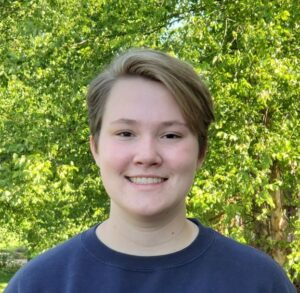This story originally appeared in the Hub.
Solar energy has yet to reach its full potential in combating greenhouse gas emissions. Obstacles such as bulky panels and sunlight availability have stymied solar energy’s impact, but the way solar cells are constructed also plays a role.
Dana Kachman, a junior in the Whiting School of Engineering‘s Department of Electrical and Computer Engineering, aims to help solar energy reach its full potential through the development of an inverted solar cell, which could enhance the power conversion efficiency (PCE) of lead sulfide (PbS) colloidal quantum dot (CQD) solar cells.

Dana Kachman
Solar cells rely on the photovoltaic effect—a physical reaction–to convert light energy into electrical energy. However, the materials used in this process and how they are arranged limit the efficiency of extracting the electrical charge from the cell. Kachman’s inverted solar cell (so-called because it flips the way the materials are layered) uses 2D transition metal dichalcogenides, a group of materials with diverse properties, including high electrical conductivity, to generate more electrical energy.
“Inverted solar cells open up additional approaches for incorporating new materials into our solar cells, allowing us to more quickly test these materials and improve the efficiency of our solar cells,” says Kachman, a member of the NanoEnergy lab, directed by Susanna Thon, an ECE associate professor and core faculty member of the university’s Ralph O’Connor Sustainable Energy Institute, also known as ROSEI.
For this work, Optica, the leading society in optics and photonics, recently selected Kachman as one of its 2023 Women Scholars, an honor shared by only 20 women worldwide each year. This year’s recipients hail from 10 countries and each receive a $10,000 scholarship and access to professional development resources from Optica, including membership and mentorship.
“Dana is an outstanding undergraduate student who is extremely deserving of the Optica Women Scholars award due to her excellence in research and dedication to optical sciences,” Thon said. “She has been conducting research in my lab since her freshman year and has contributed several important discoveries to the field of optical materials and devices for solar energy harvesting.”
Next steps in Kachman’s solar cell research involve incorporating 2D transition metal dichalcogenide materials into the inverted solar cell. To do this, she will collaborate with groups at Morgan State University that specialize in creating high-quality films of these materials through the U.S. Department of Defense’s Center of Excellence for Advanced Electro-Photonics with 2D Materials, a joint Morgan State-Hopkins effort.
“A lot of work has been done on creating [materials for use in solar cells] using various processes such as chemical vapor deposition, physical vapor deposition, and sputtering, which each allow us to get high quality large-area films,” Kachman said. “However, these methods all share a common need for high temperatures during the process, which our CQDs can’t withstand. An inverted solar cell structure will allow us to accommodate these high temperatures without damaging the solar cell.”
Recognition by Optica is not the only honor Kachman recently received for this work. Her paper, “Improving the Performance and Yield of Colloidal Quantum Dot Solar Cells through Electron Transport Layer Optimization,” was selected for an oral presentation at the 2023 IEEE Photovoltaic Specialists Conference, the premier conference in the photovoltaics field, to be held in June in San Juan, Puerto Rico. (Kachman is first author of the study.)
Thon says that Kachman will likely be the only undergraduate at the conference giving an oral presentation.
“The fact that Dana had her paper accepted for an oral presentation as an undergrad is remarkable,” Thon said. “Dana will be a rising senior when she attends, and the conference will give her a chance to meet a broad swath of researchers in our field, hopefully resulting in new research ideas as she prepares to apply to graduate school.”
Kachman began working with Thon in 2021, drawn by the NanoEnergy Lab’s work in nanomaterials and renewable energy.
“When Professor Thon first introduced me to the concept of colloidal quantum dot solar cells, I found it really exciting, and I felt this was a perfect way to incorporate my interests in nanomaterials and renewable energy into a research topic,” Kachman says. “We are trying to make cheaper, more efficient, and more versatile solar cells. In addition to rooftop and large array deployment, these solar cells can be used for flexible energy generation, such as on cars, for mobile devices, or even to be incorporated into fabrics and clothing, broadening the applications for solar energy.”